



This week for Flora and Fauna Friday it’s a curious coastal shrub that’s as good at inflicting pain as it is at killing pain, Southern Prickly-Ash (Zanthoxylum clava-herculis).
Southern Prickly-Ash is a small tree in the citrus family found scattered across the coast of the Southeast United States. Here in South Carolina, it’s limited to the Lowcountry and primarily to barrier islands and Sea Islands, like Edisto. It’s a common sight on beaches and in sandy forest edges further inland. Southern Prickly-Ash has a gnarled growth, pale-gray bark, leathery emerald-green compound leaves, and is covered in corky protrusions and prickles. It generally grows about ten to twenty feet tall with multiple stems. Southern Prickly-Ash goes by many names including, Toothache Bush and Hercules’ Club, and each alludes to a different characteristic. The name Hercules’ Club references the trunk of the plant. The club of the Greek hero Hercules is often depicted as being covered nodules or conical points and indeed our plant is covered in pointy conical nodules all along its stem. Southern Prickly-Ash tells us the plant is found in the south, it’s prickly, and it resembles an Ash tree. Conveniently, it is all three. Both the stems and the trunk of Southern Prickly-Ash are all covered in vicious woody prickles and the prickles on the trunk eventually transition with age into corky pyramids. (Prickles is the technical term here, as these pointy bits are grown out of the plants’ bark. Thorns grow out of the wood of the stem and spines are modified leaves.) Also, its leaves do in fact look a bit like an Ash, with a pinnately compound leaf usually holding seven to nine leaflets. However, the most intriguing name is Toothache Bush. The leaves of Southern Prickly-Ash are glossy with a burgundy rachis down the center studded by prickles between the leaflets. They are also thick and leathery. As these plants often grow in stressful habitats with poor soils and these leaves take a good deal of work to grow, they strongly prefer if critters don’t make their lives any harder by eating their leaves. To this end, they have covered themselves in prickles and have also invested in chemical warfare. The flesh of Southern Prickly-Ash contains chemicals designed to repel and incapacitate insect pests. One of those chemicals is spilanthol, which kills insects but can work as a local anesthetic in humans. Traditionally, Native Americans often used it to treat toothaches, as chewing on the twigs or leaves of Southern Prickly-Ash will numb the mouth and tongue with a tingling sensation that allows you to ignore mouth pain. However, this chemical warfare isn’t perfect and I know of one species of insect that has learned to tolerate it, the Giant Swallowtail. The Giant Swallowtail is our largest species of butterfly in the South Carolina and its native host plant is Southern Prickly-Ash. Southern Prickly-Ash is also important to other wildlife. It blooms in mid-spring with cluster of tiny green flowers utilized by pollinators and produces small black berries eaten birds.
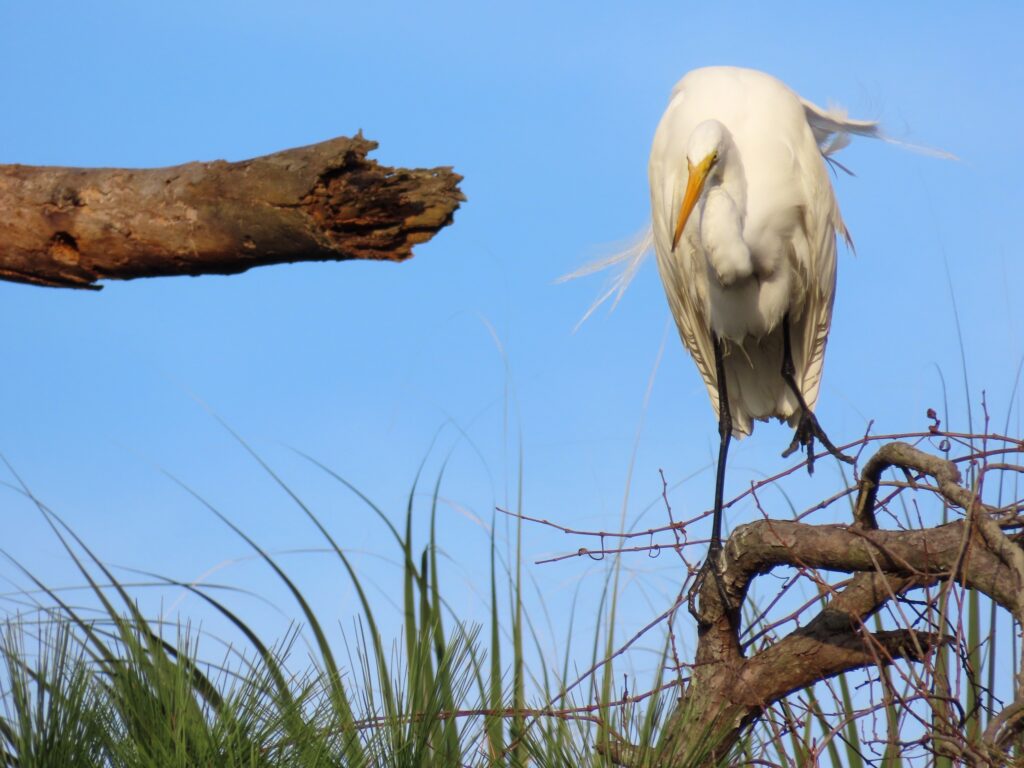

This week for Flora and Fauna Friday is a big alabaster bird we’re all familiar with, the Great Egret (Ardea alba).
The Great Egret is found in temperate coastal areas and tropical wetlands all across the globe. Here in South Carolina, it is most common in the tidelands of the Lowcountry but can crop up along wetlands throughout the state. The Great Egret is a large wading bird, standing about three feet in height, with slender features and an S-curved neck. They’re plumed from chin to tail with feathers of icy-white and lacking any discernable markings. They have long black legs, pastel-yellow eyes, and a golden-yellow, dagger-shaped bill at the end of an even longer neck. Great Egrets stick out like a full moon at midnight as they stand offshore in their preferred pluff-mud floored salt marsh habitats. However, believe it or not, this unpigmented plumage is their camouflage. It’s just that they’re hiding from fish and not from you. Great Egrets are ambush hunters and their prey are fish and crustaceans. By donning a blinding white coat of feathers, they can stand in the middle of the water in front of the sunlit sky and go unnoticed from those below the rippled surface. Their feathers act like a mirror for the light reflected off the water and their featureless plumage blends in with the infinite expanse of sky. Just another cloud. In the turbulent shallows they hunt in, that’s all it takes to disappear in plain sight. It also doesn’t hurt that their black legs blend in with the dark sediment, their front profile is very narrow, and they use forward speed to ambush their prey. Great Egrets, like other Herons and Egrets, use their sharp, pointed bill to grab, or occasionally impale, their prey. They do this by folding their neck into an “S” and then launching their bill straight forward with blinding speed. This direct, forward strike minimizes lateral movement and inhibits their prey’s ability to see the attack coming.
Great Egrets are solitary hunters but they tend to sleep in groups for protection. They also nest in groups in areas called rookeries. Rookeries tend to be in trees hanging over or growing in standing water or marshes and are often filled with nests of many different species of wading bird. Wading Birds do this to limit predation from Raccoons, Opossums, and Owls by concentrating in one small area and using the water, and any alligators swimming in it, as a deterrent. Leading up to the nesting season, mature Great Egrets will grow plumes from their back and the skin around their eyes will turn a brilliant chartreuse. Their elegant plumes are thin, covered in wispy barbs, and trail almost to the ground. Around the turn of the 20th century, these plumes were highly prized for use in women’s fashion and the Great Egret, along with other American wading birds, were nearly extirpated from the United States. Thankfully plume hunting was banned shortly into the 20th century and Great Egrets have made a splendid recovery.
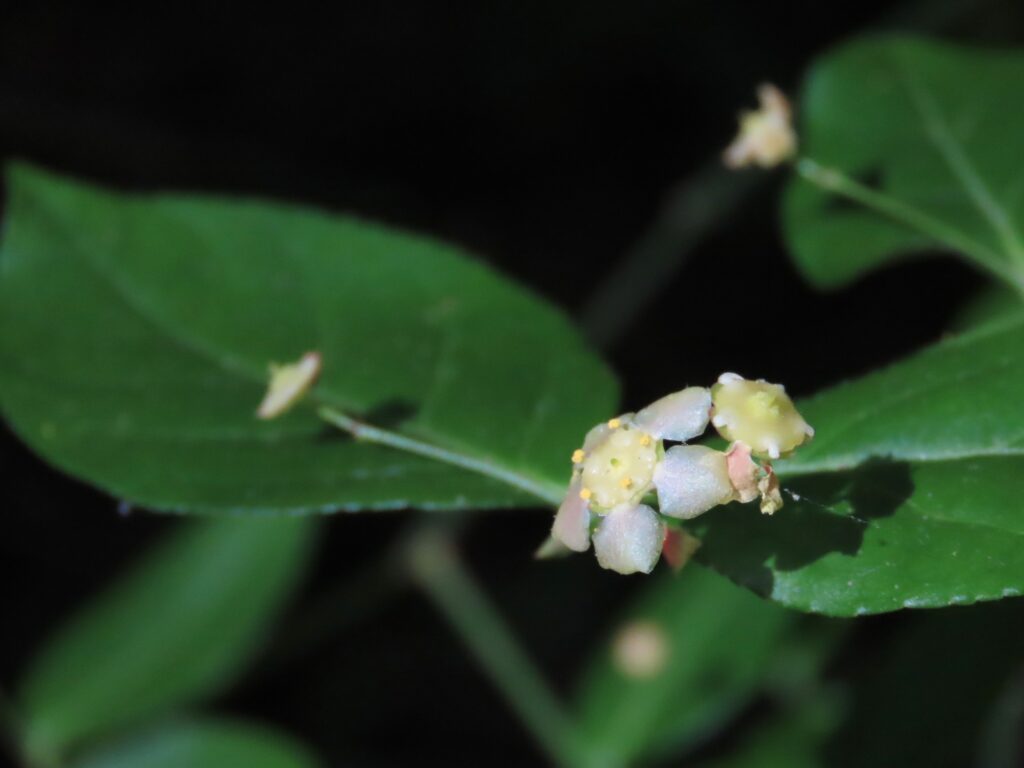
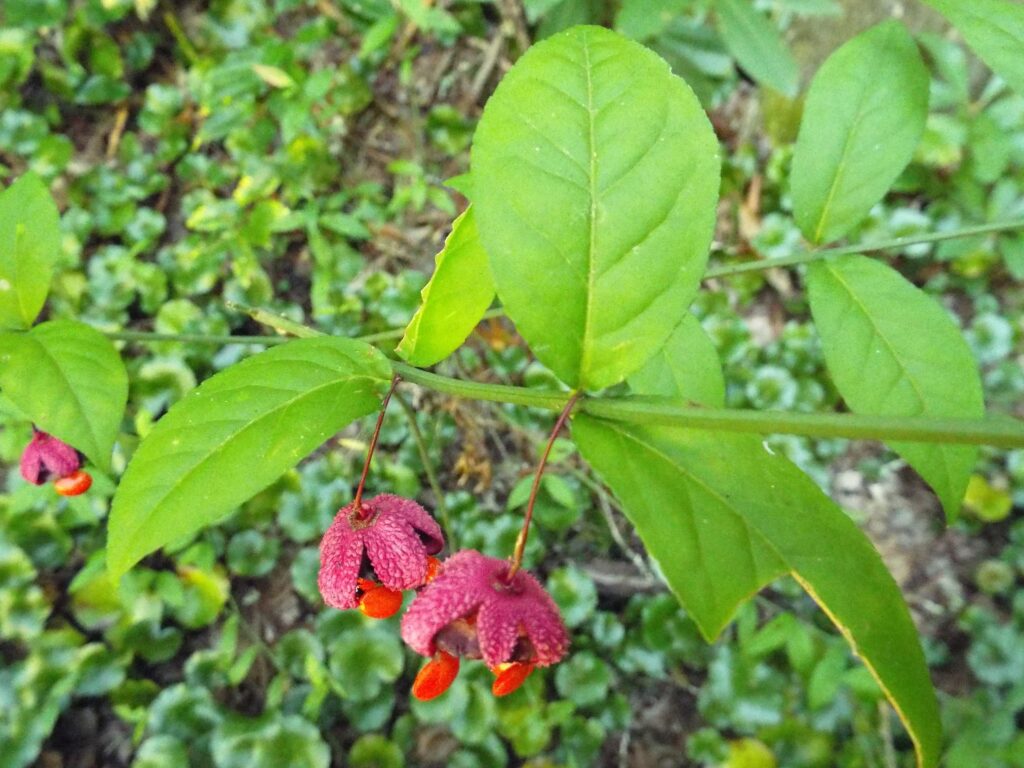
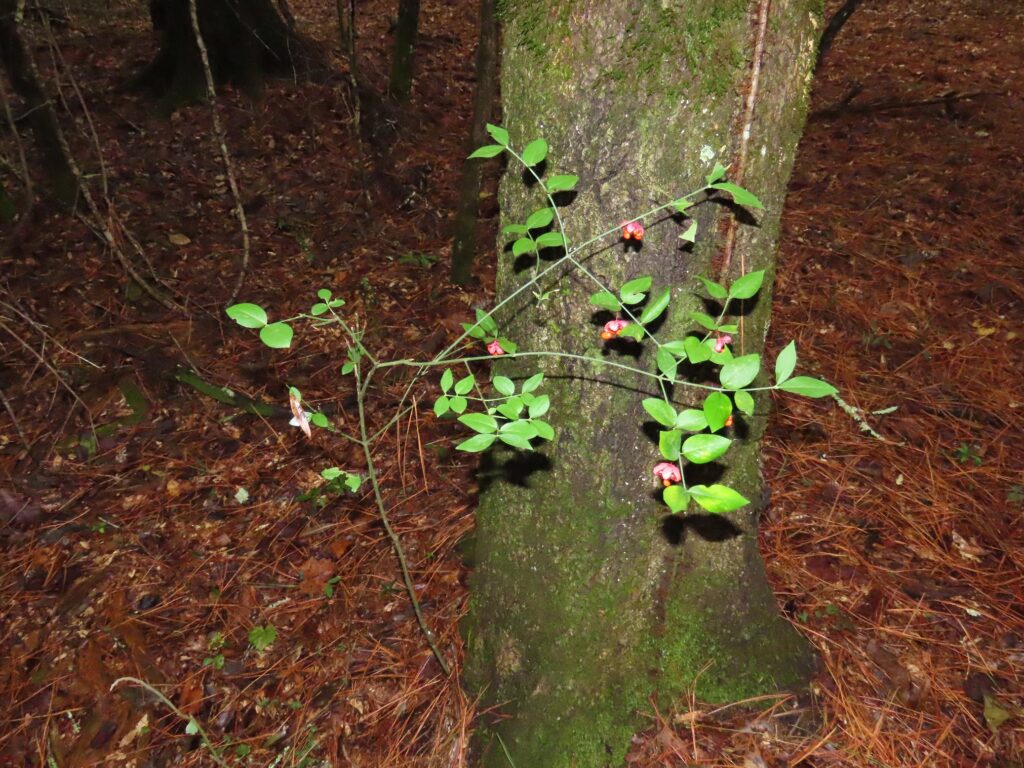
This week for Flora and Fauna Friday we have a showy shrub of the Southeast, Hearts-a-Bustin’ (Euonymus americanus), AKA American Strawberry Bush.
Hearts-a-Bustin’ is a small to medium-sized deciduous shrub found throughout the Southeastern United States. It’s a fairly common sight in moist forest understories, as it is tolerant of deep shade, but it does best on forest fringes with partial shade. Heart’s-a-Bustin’ is an easy plant to identify but also one that can be easy to overlook at certain times of the year. It has thin, spindly, solid green stems and a somewhat unkempt growth-form, usually with multiple stems. Its leaves are small, simple, and ovular with a pointed tip and can be quite thick, almost leathery, when the shrub is small. Leaves are arranged opposite each other on the stems and are the same shade of green as those stems. This monochromatic character is a rather unique combination and is often enough to identify it with just a glance. Heart’s-a-Bustin’ is a favorite food of White-tailed Deer and, leading up to winter, they often get browsed down until they’re nothing but a collection of green stems. If the deer don’t strip them bare by fall, their leaves turn a shade of crimson-red before falling to the forest floor. Heart’s-a-Bustin’ blooms twice each year, once at the end of April and again at the end of September. Small five-petalled, green-white flowers with a tinge of pink and a lime-green center emerge from the ends of long, thin pedicels that anchor back below the base of a leaf. Each flower has a twin on the other side of the stem. These flowers will mature into a unique looking fruit that gives this plant its many names.
The fruit of Heart’s-a-Bustin’ is a capsule that’s dyed an eye-catching shade of magenta and textured with many small conical points. At a glance it resembles a Strawberry but up close there’s no comparison and the best analogue for its shape is a Sea Urchin. As this capsule ripens, it dries and eventually splits apart at the bottom to reveal up to five bright-red fleshy seeds that dangle downward from the tip of each arm of the capsule. These fleshy seeds are known as arils, the same type of seed produced by Magnolias. Arils are biologically different from a drupe in that the flesh that grows around the seeds originates from the seed itself and not the fruit of the parent plant. They’re also poisonous, so don’t eat them. These capsule-aril combos are quite a striking sight and make identification of the shrubs a breeze when they’re fruiting. In case you’re wondering, the name Hearts-a-Bustin’ doesn’t have any deeper cultural meaning to it that I can find. It’s simply a poetic, romantic name for a reddish-purple fruit that bursts apart.
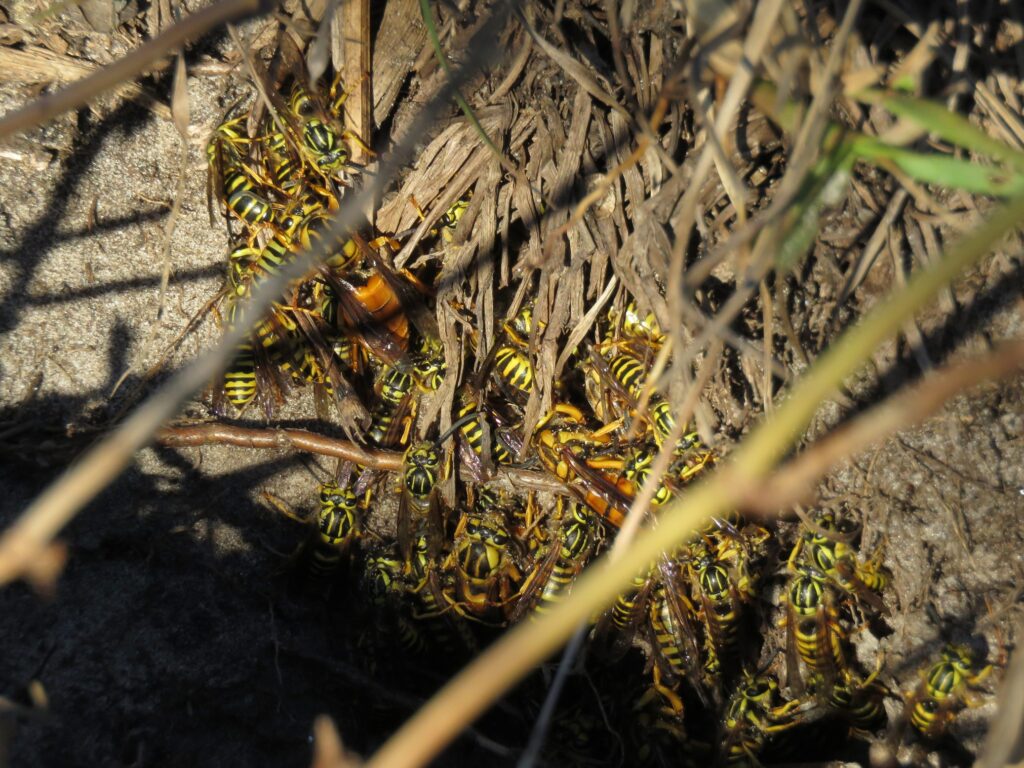
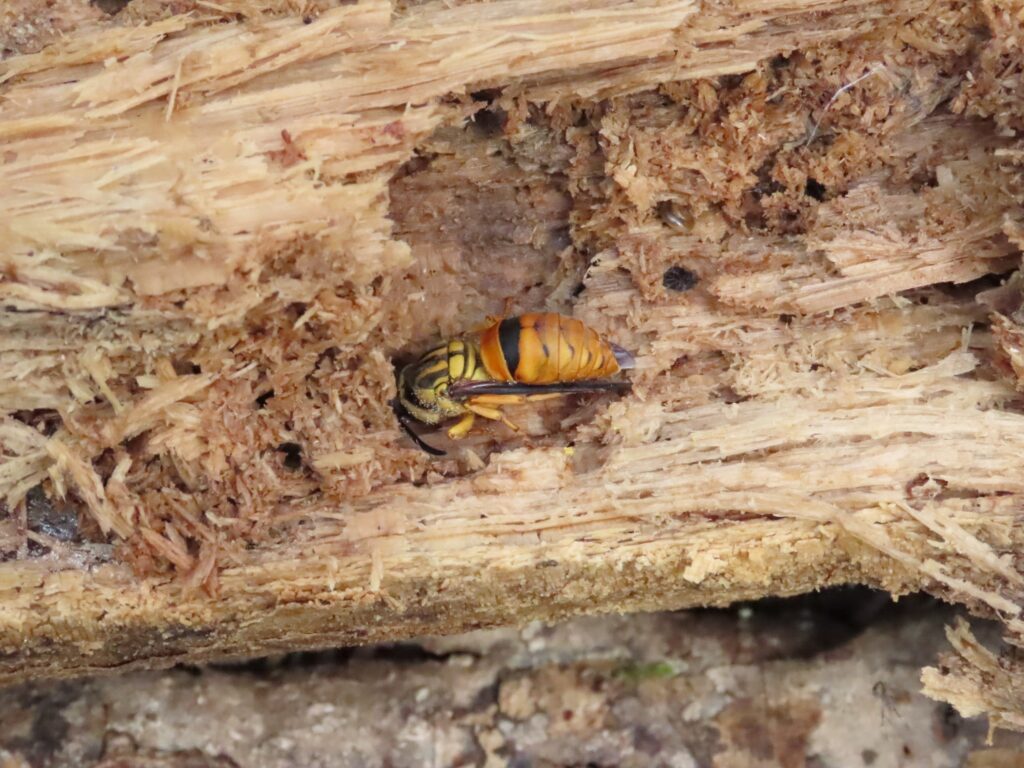
This week for Flora and Fauna Friday it’s a bunch of black and yellow insects with bad attitudes, Yellowjackets (Vespula spp.) or colloquially referred to as “Ground-Bees”.
Yellowjackets are members of the family Vespidae which includes its equally notorious cousins: the Hornets and Paper Wasps. Here in South Carolina we have two species of Yellowjacket, Eastern (V. maculifrons) and Southern (V. squamosa), with the Southern Yellowjacket being most common in the Lowcountry. Both are very similar in appearance with a black body ringed by numerous vibrant-yellow bars. Yet the two species are easy to tell apart up close, as the Southern has two lengthwise stripes on the back of its thorax and the Eastern has a solid black center to its thorax. Yellowjackets, like bees, have castes comprised of queens, workers, and males. Workers are the typical Yellowjackets you encounter and are smaller, infertile females. Males look very similar to the workers but have a slightly elongated abdomen and antennae. Queens are larger, fertile females with proportionately more yellow on their abdomens. Southern Yellowjacket queens are distinct in that their females tend to have a golden-orange abdomen with very little black. Whereas eastern queens have a more sunflower yellow abdomen with two lines of black spots. Yellowjackets live in large colonies and build paper nests underground or in rotten stumps and can reach the size of a watermelon. If you’ve ever seen a Yellowjacket, or other wasp, chewing on a log or wooden handrail it’s because they’re harvesting wood pulp for building their paper nests. Yellow Jackets primarily live in forest habitats but will occasionally nest in more open areas. Colonies generally only last a year with most of the individuals dying off over winter. However, freshly hatched queens will venture off from their home colony to hibernate in rotting logs and leaf litter over winter, so they can start their own nest come spring.
Yellowjackets have an interesting diet. As adults, they eat nectar, fruits, and anything sugary they can get. That makes them a frequent visitor of both hummingbird feeder and jelly feeders, and they will happily climb into your soda can when you’re not watching. However, when they start life as wee larvae stuck in paper cradles, Yellowjackets are almost entirely carnivorous and insectivorous. Adult workers will scour the forest in search of arthropods to hunt and carcasses to scavenge. When they bag a juicy bug or stumble upon roadkill, a filleted fish skeleton, or your ham sandwich they will chew it up and carry it back to the nest to feed those growing baby wasps. Whether they’re feeding their larvae or themselves, Yellowjackets make sure to let the rest of the nest know where they found that food and, before long, whatever it is will be swarming with Yellowjackets. They’re fairly territorial about their food but take the security of their nests to the extreme. Their black and yellow coloring is a warning that these trigger-happy insects are armed with a venomous sting and, unlike bumblebees and most wasps, those colors aren’t a half empty threat. If you’re unlucky enough to stumble over a Yellowjacket nest, you’ll be in for a world of hurt as they’ll swarm anything that wanders to close, sting it repeatedly, and chase it until it’s long gone.
Yellowjackets get a bad rap and, if I can be frank, it’s deserved. They’re the most aggressive animal I’ve encountered in my years ambling about the Lowcountry. Forget Cottonmouths, Coyotes, and Alligators, Yellowjackets are the only thing I’ve seen that’ll make a beeline from twenty foot away to ruin your day for seemingly no reason. I can’t count the number of times myself or a companion have been stung out of nowhere by a Yellowjacket with a chip on its shoulder. Yet, even with their sour dispositions and painful sting, they still have their predators. In the upstate, bears and skunks dig up their fair share of Yellowjacket nests but here on the coast, their number one predator is the Armadillo. An Armadillo’s armored hide and stout claws make the underground larvae of both Yellowjackets and ants an easy target for them!
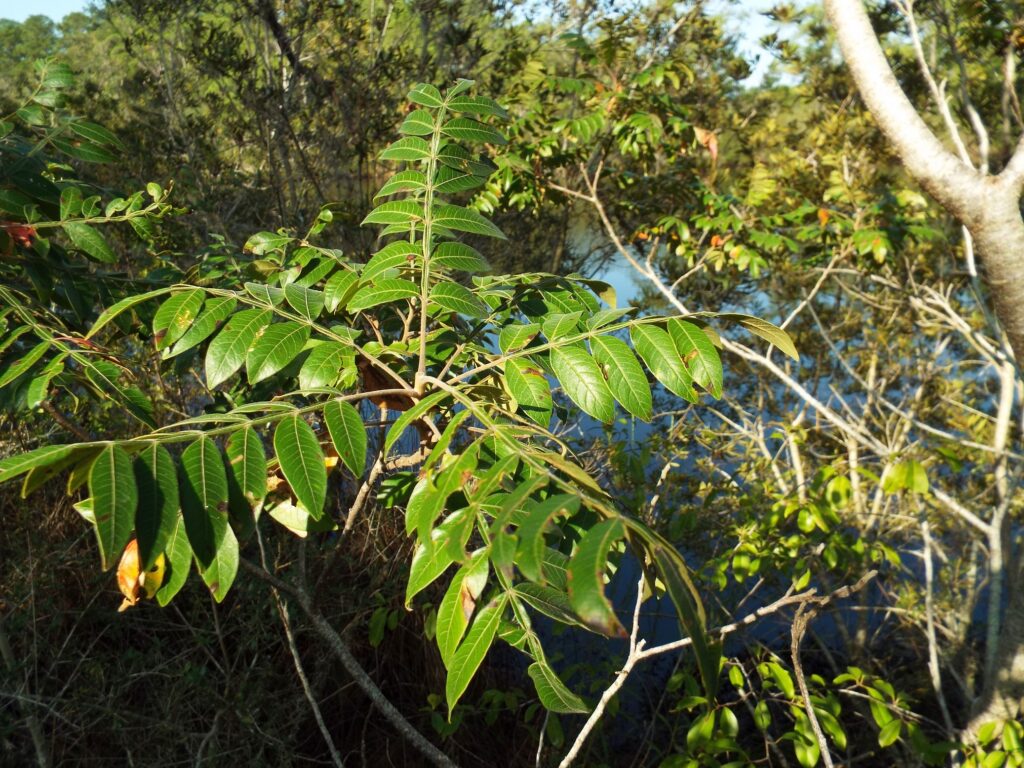
This week for Flora and Fauna Friday is a simple spindly shrub of scrublands and shaded woods, Winged Sumac (Rhus copallinum).
Winged Sumac, AKA Shining or Flameleaf Sumac, is a large woody shrub, bordering on small tree, that can be found throughout South Carolina and the Eastern United States. It can grow in just about any soil regardless of fertility, tolerates both infrequent flooding and periodic drought, and will grow fine in both partial shade and full sun. It can reach fifteen feet in height but most often hovers around ten feet. Its growth is multi-stemmed with several irregularly shaped, but otherwise straight, narrow stems rising from a single point of soil. The stems grow together into a hot-air-balloon shape, a ball of foliage floating over several thin supports. Winged Sumac tends to grow into loose thickets, either by clonal creep through the roots or offspring germinating near their parents.
The leaves of Winged Sumac are how it gets three of its common names. Each leaf is large and pinnately compound with a dozen or more leaflets. These leaves are a deep green in summer with a glossy sheen, which is where they get the common name of Shining Sumac. The central vein of this compound leaf also has narrow wings between each leaflet, which is the easiest way to identify this species and the origin of the Winged Sumac name. Finally in fall, these leaves turn a brilliant scarlet-red which earned it the name of Flameleaf Sumac. Winged Sumac blooms throughout the year with easy to miss yellow-green, hand-sized flower clusters at the end of each branch. These flowers mature into small dark-red drupes. The drupes are eaten by birds fresh but will also dry on the stem and remain as a food source for songbirds throughout winter. These miniscule fruits are actually edible for humans and can easily be made into a fruit drink by steeping the crushed fresh fruits in water overnight. The fruits can also be dried for use as a cooking spice. On top of its culinary utility, Winged Sumac is a good choice for urban landscaping and as a residential ornamental due to its tolerance of a variety of growing conditions, compact size, and beautiful fall foliage.
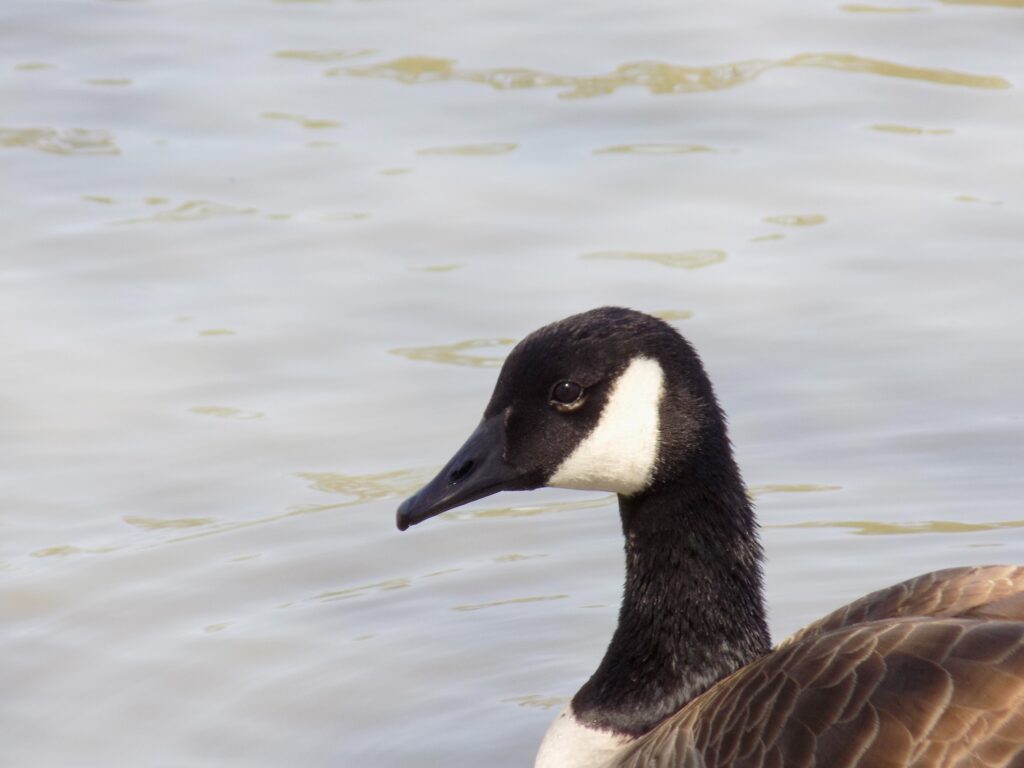
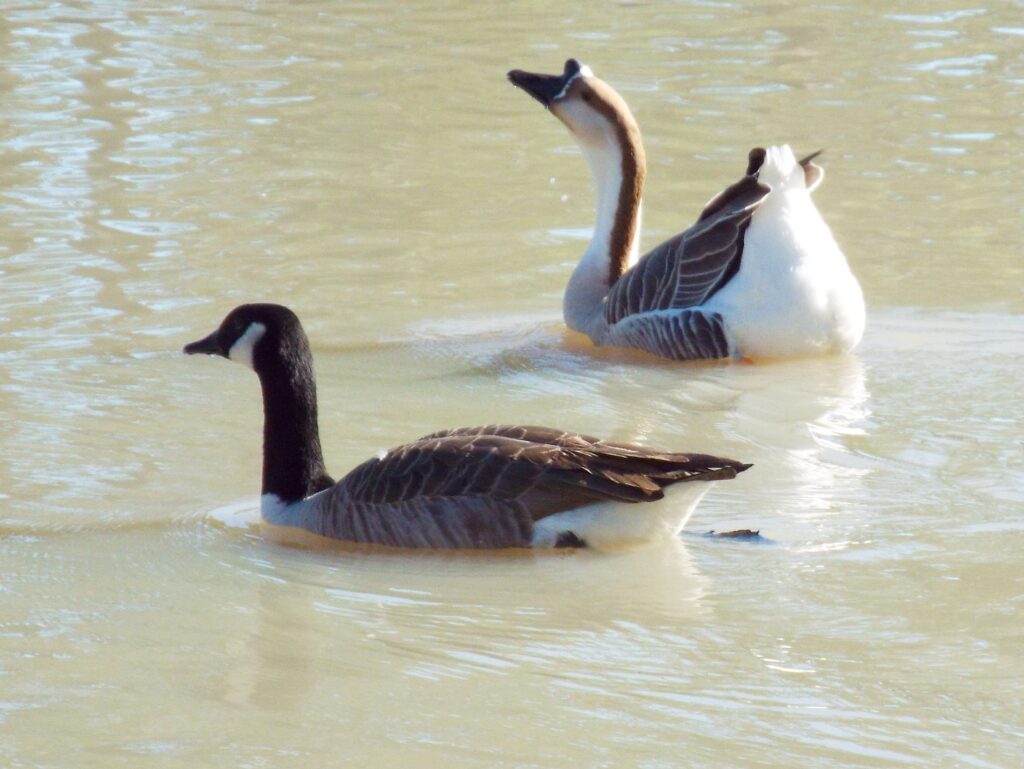

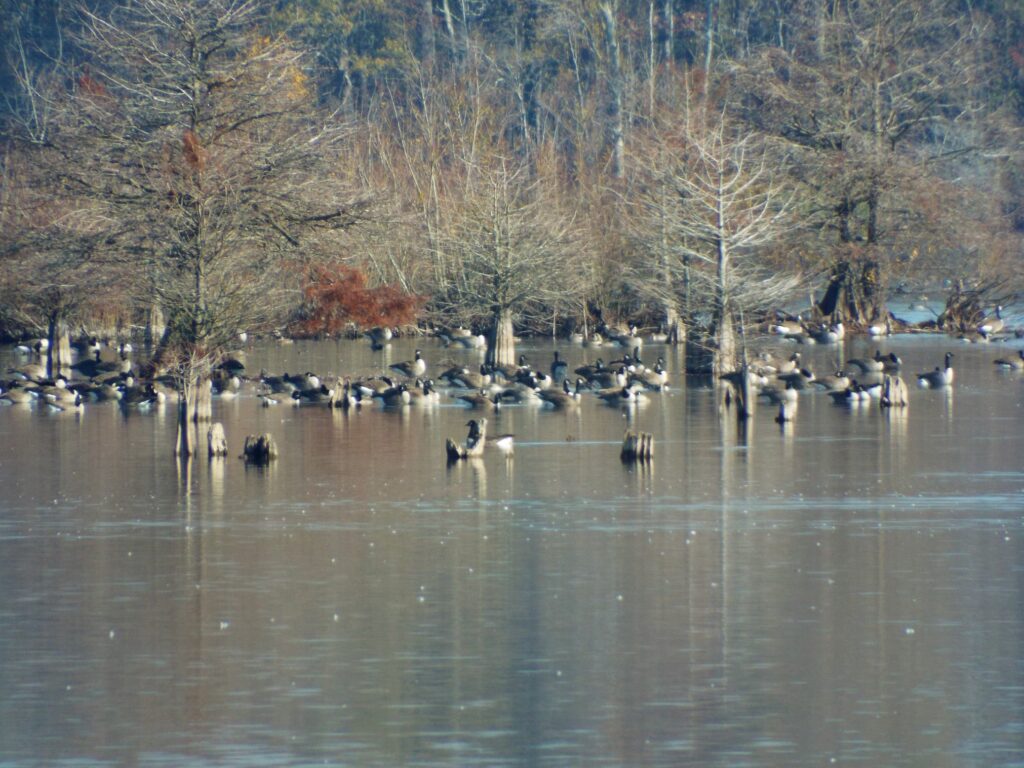
This week for Flora and Fauna Friday, it’s the haughty honkers who herald the holidays: the Canada Goose (Branta canadensis).
Fall in the Lowcountry is a mysterious thing. One day the temperature dips into the 40s and the next week it’s in the 80s again. Some trees turn a bit yellow for a week, others put out new leaves before they finish dropping their old ones, others stay green forever, and some just down turn brown until March. Before you know winter arrives and there never seems to have appeared an autumn. Yet, one beast makes their presence known to signal that the change of season is complete, the Canada Goose.
The Canada Goose is by far our most populous goose here in the Southeast. Their range extends throughout much of the United States and they can be found practically anywhere in South Carolina. They’re a large bird, standing about hip high and weighing 10-15lbs. Canada Geese have a plumage of blacks, whites, and dull browns. A black bill and black eyes upon a black head and neck, broken-up only by a snow-white beard, swoops down to a pale-khaki breast which slowly steps through thin streaks to a muted-brown flank below wings and mantle of the same shade. Beyond the brown wings are their black wingtips and beyond the brown flank is an egg-white rump. Beneath it all it is the support of two sturdy black legs on broad webbed-feet. Canada Geese generally travel in flocks but can often be seen in just as a pair. They may be found in practically any open body of still freshwater from lakes and ponds to borrow pits and golf course water hazards. However, Canada Geese are not restricted to the water and they spend much of their time on land. Canada Geese eat vegetation and can often be found on farm fields, pastures, lawns, and the like plucking grass and swallowing seeds.
This leads us to something interesting about Canada Geese here in the Lowcountry. We actually have two distinct populations here in the winter. One population migrates south from Canada, the Midwest, and the northeast and their populations can predominantly be found in huge numbers on the lakes of the midlands and other secluded waterfowl habitats of the state during only the winter. Conversely, we have non-migratory Canada Geese who spend their whole lives within South Carolina, moving about their local area seasonally. These local resident Geese are the ones we see the vast majority of the time and the ones found in urban and residential areas upon retention ponds, borrow pits, and water hazards and meandering through parking lots, housing developments, airports, and golf courses.
These resident Geese can actually become major nuisances not just by hissing at unsuspecting pedestrians or foiling fastidious landscapers but also by degrading local water quality and preventing safe aviation. The most obvious big issue Canada Geese present is that a flock of 15lb birds flying into a jet turbine generally does not result in a favorable outcome for either party. So airports go through great efforts to keep Geese out of airport retention ponds and off of runways. What’s a little less obvious is that Geese can be a massive issue for local water quality. Geese eat a lot of grass, like to swim around in small ponds, and don’t like alligators or walking around in tall grass. We humans love to surround small, mostly alligator-free ponds with lush, short grass. So ponds in residential or urban areas are a perfect habitat for packing as many Canada Geese into a small space as possible. This also means that a lot Goose poop ends up in those ponds through run-off, or more direct means. This can quickly turn an otherwise functional and ecologically healthy retention pond into a cesspool which, instead of sequestering contaminants, now becomes a source of bacterial pollution flowing into our waterways. A few Geese is usually not an issue but dense populations can become harmful very quickly. Proper pond and landscape management is required to discourage Geese from overpopulating these areas and the SC-DNR has plenty of resources on how to better manage ponds to control geese.

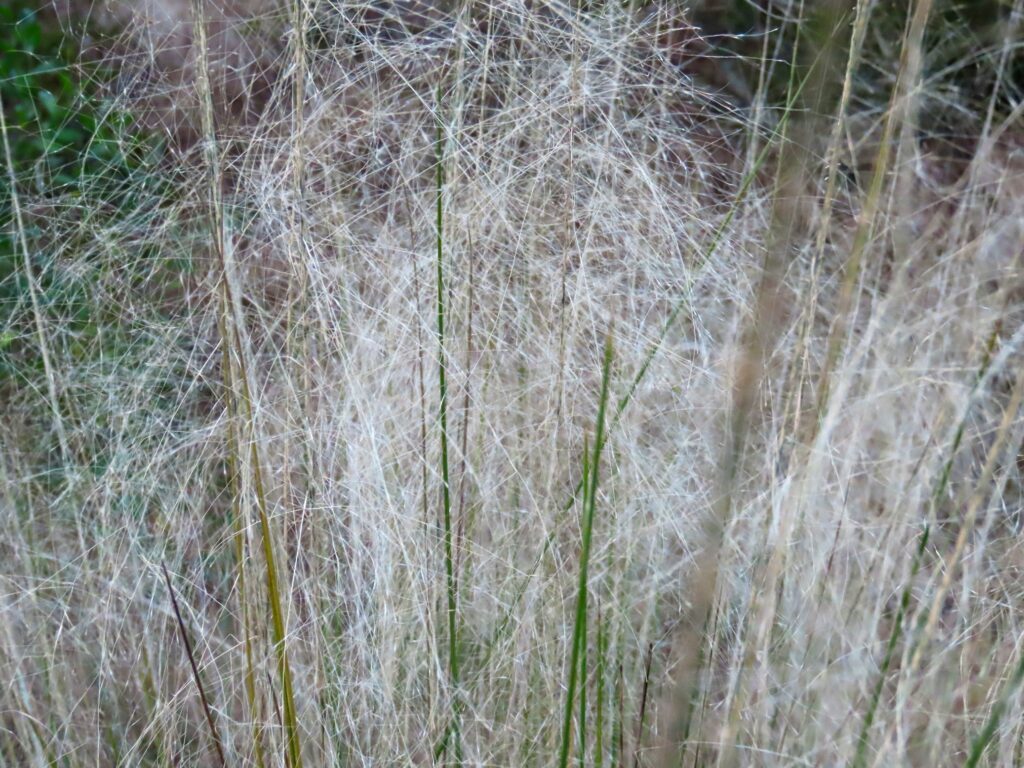
This week for Flora and Fauna we have a culturally significant coastal grass to discuss: Sweetgrass (Muhlenbergia filipes).
Sweetgrass goes by many names but Sweetgrass or Purple Muhly Grass are the most oft used. It’s a large clumping grass, usually growing to waist height, which prefers sandy coastal sites. You’ll most often see it growing between beach dunes, in the understory of hammock and barrier islands, on the fringes of the high marsh, and in the understory of fire-singed pinewoods. The foliage of Sweetgrass has thin, needle-like leaves and is a shade of emerald-green. The grass’ shape takes a domed appearance as its thin blades arch and pile atop each other into a round clump. At the sunset of summer, Sweetgrass will begin to bloom. Long thin flower stalks will swell the circumference of each cluster of grass to near chest height as they burst forth into a purple haze. A fog of tiny magenta flowers will settle over the plant, making an otherwise innocuous grass unmistakable. The plants will continue to bloom well into fall and the flowers will eventually fade to dried, dull-white stalks laden with their miniscule seeds. Sweetgrass is a hardy perennial and will persist for many years.
Sweetgrass also has quite the cultural significance here in the Lowcountry. They are the primary material used in the eponymous Sweetgrass Baskets that the Gullah people have been handcrafting for some 300 years here in the Lowcountry. Other native plants, like Palmettos and Black Needlerush, are also used in the basket making art but Sweetgrass is the heart of each piece. Sweetgrass, along with other species of Muhly Grass, are also cornerstones in any native plant landscaping effort here in the Lowcountry. Being a native plant well adapted to our blistering climate, sandy soils, and both drought and flood, they make a perfect addition to most any coastal landscape plan alongside staples like the Palmettos, Live Oaks, and Yaupons.
Yet despite its hardiness and importance, wild Sweetgrass has experienced significant declines in the last century. Coastal development of our beaches and marsh edges have removed habitat from the Sea Islands and the multi-decade long suppression of fire in forestlands degraded much of its habitat in island interiors and along the mainland coast. Modern forest management techniques have restored fire to many of our forestlands and the use of native plants in landscaping have brought plants back to where they once grew but Sweetgrass populations still remain sporadic in much of the Lowcountry.
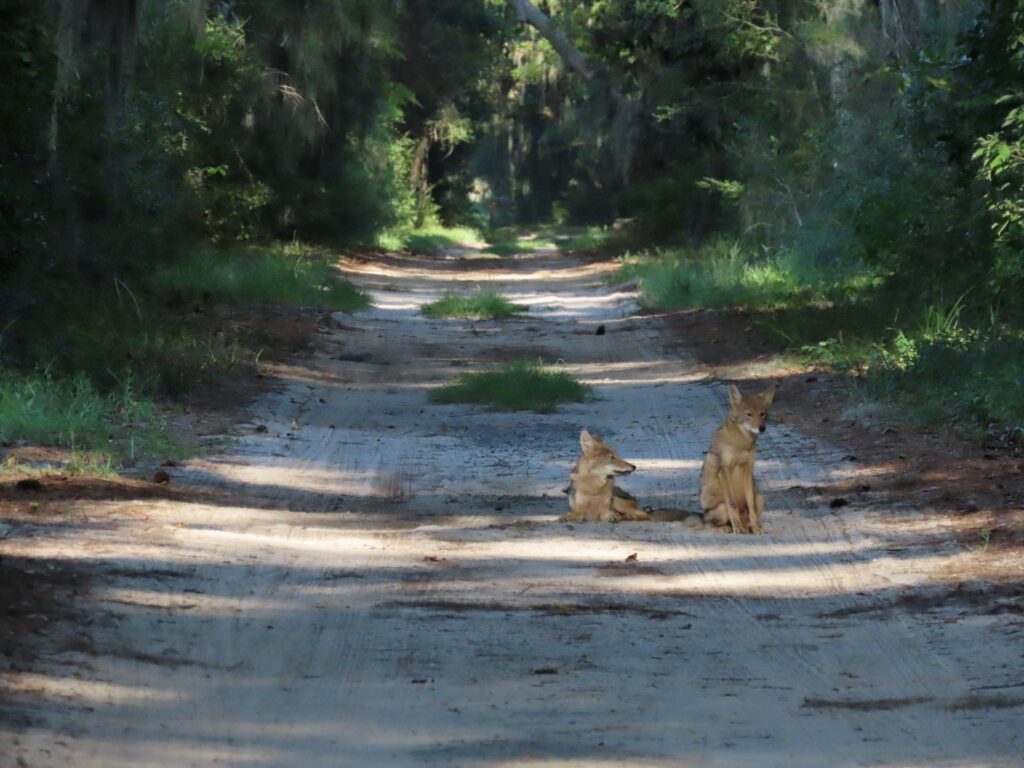
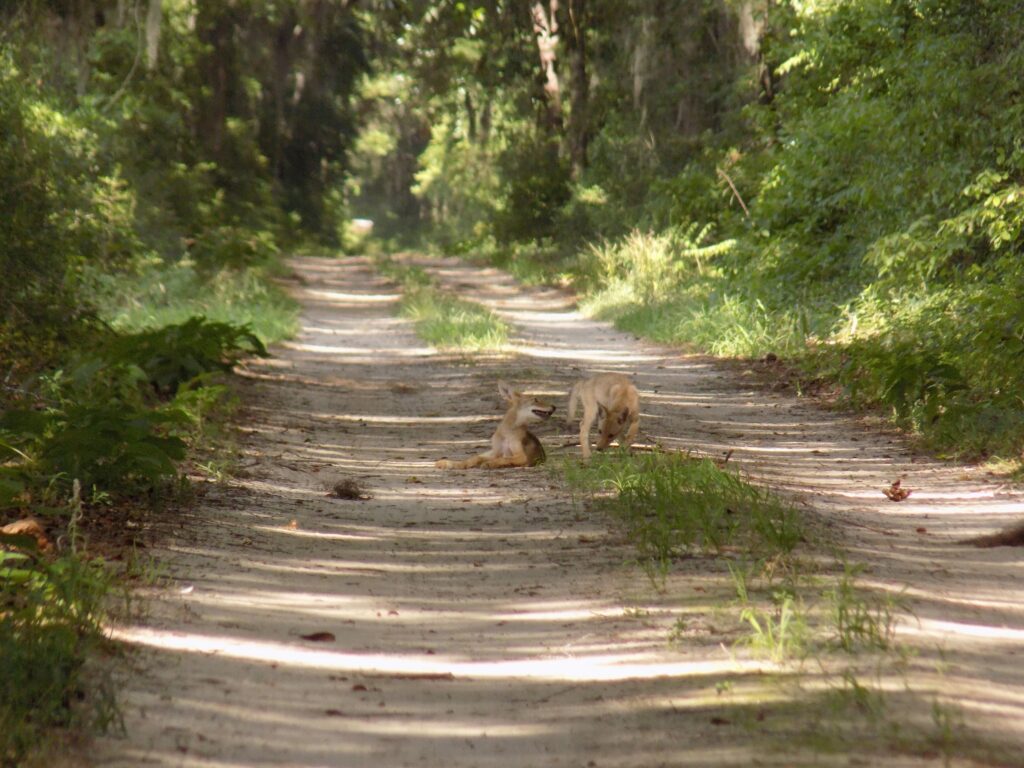
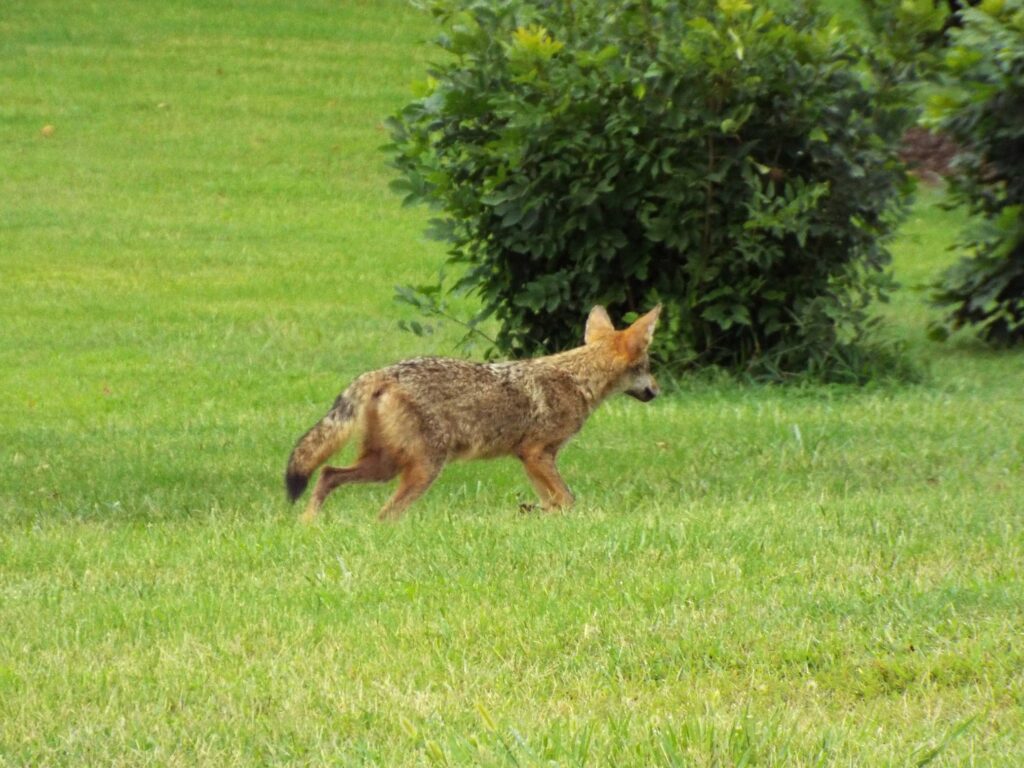
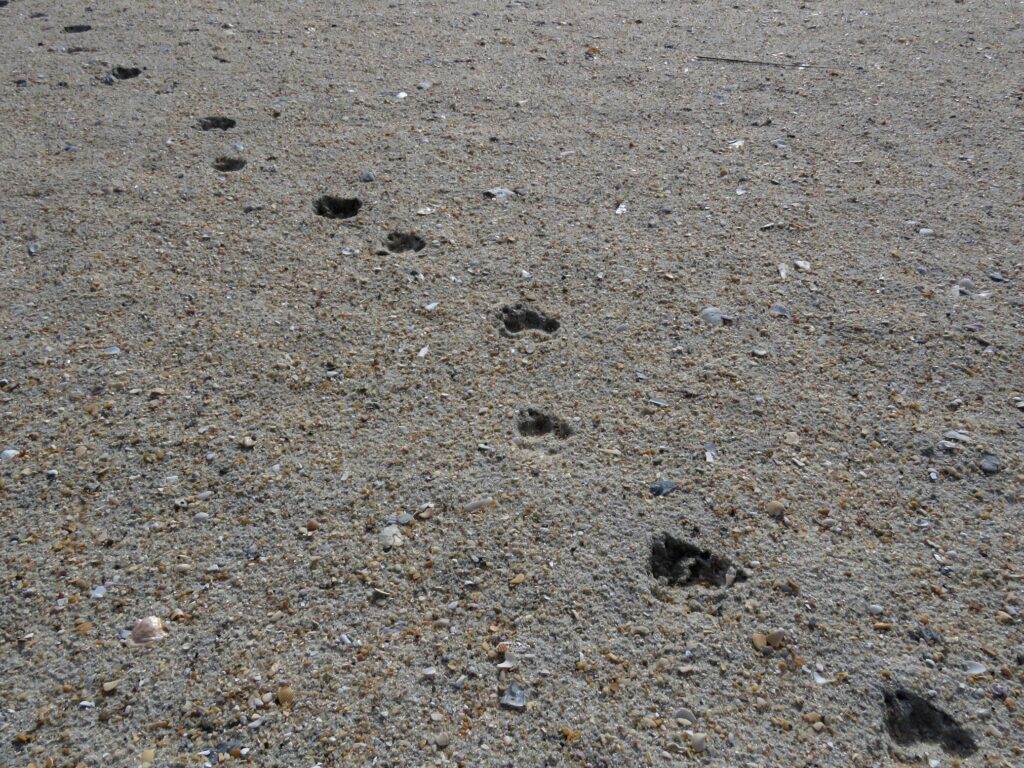
This week for Flora and Fauna Friday we have a contentious critter of the Canid kind, the Coyote (Canis latrans).
The Coyote is a medium-sized member of the family Canidae and belongs to the same genus as wolves and dogs. They’re larger than both our Red and Gray Foxes but smaller than most dog breeds. Coyotes are a tall, lanky predator with large triangular ears and a long, pointed snout. This gives them an overall scrawny appearance. Their fur is short and blended with tans, reds, blacks, browns, grays, and whites throughout down to their fuzzy black-tipped tail. They’re mainly nocturnal, spending their nights patrolling their territory on the hunt for rodents, roosting birds, and meso-mammals. During the day they sleep it away in dens they’ve made or appropriated from another critter.
Coyotes are an adaptable species. They’ve adjusted to life in the swamps, suburbs, and sandy shores of South Carolina. Locales quite unlike the prairies and deserts from whence they hail. In fact, they’re a little too adaptable for most people’s liking. As Coyotes have moved east, they’ve not only gotten bolder but bigger, owing to hybridization with dogs. The scrawny and cowardly coyote of old is coming into its own, filling the niches the Eastern Gray Wolf and Red Wolf once held. This is where they get into trouble. Without that fear of the big bad wolf bearing down on them, the Coyote has taken up the mantle of their former bullies. Although they’re far from forming packs and cornering cattle, Coyotes will prey upon small livestock and newborn calves. They’re also notorious for hunting outdoor cats and they’ll occasionally harass dogs. However, given that a typical hound-dog or retriever is two or three times the weight of our svelte southern Coyotes, they usually avoid such confrontations.
Just like the Nine-banded Armadillo, the Coyote has had a recent relocation to the Lowcountry. Only in the last 80 years has the Coyote crossed the Mississippi; only in recent memory has it become thoroughly established in the Lowcountry. Coyotes are one of those creatures humans have unwittingly rolled out the red carpet for, paving their way across a new frontier. Just like with Mockingbirds and Cattle Egrets, we opened the door wide open for them without even knowing it. When Europeans colonized North America, they proceeded to extirpate wolves, bears, and cougars from everywhere they could. They were particularly adept at removing wolves. In this wake of wolflessness, the Coyote seized its opportunity and washed across the Eastern US. You see, not only are Coyotes smaller than wolves, they’re less socially complex. They operate more like a fox, rolling solo and eating smaller game. They don’t have complex hierarchical social structures either. This type of lifestyle makes them warier of threats and less susceptible to ecosystem alterations. Thus, humans have had a devil of a time trying to get rid of Coyotes and the Coyotes have only gotten savvier in the process. Now they’re found across the entire United States and they won’t be going without a fight.
This week it’s a genus containing some of our most widespread weedy wildflowers: the Vervains of genus Verbena.
We have seven species of Vervain found in the Lowcountry but only five that are common enough in our area for me to consider discussing. Of those five, regrettably, only one is native. However, those exotic Verbenas are not noxious nor particularly invasive. In my eyes, they tend to do more good than harm wherever the crop up. These Verbenas are hardy perennials and have the capabilities to grow well in habitats where little else does and they all produce nectar useable to our native pollinators. Often, they are the only nectar sources in an area during the dogdays of summer and the non-native species can be an important part of degraded or urban ecosystems.
Our one native Verbena for today is Carolina Vervain (Verbena carnea). It’s a small plant, only getting twelve to eighteen inches in height, and produces a long stalk of sparsely arranged flowers. These flowers are a short, five-petalled tube with white petals and a magenta base. Carolina Vervain grows in some of the harshest habitats the Carolinas have to offer, including sand barrens and pine barrens. It blooms in May each spring on a solitary stem.
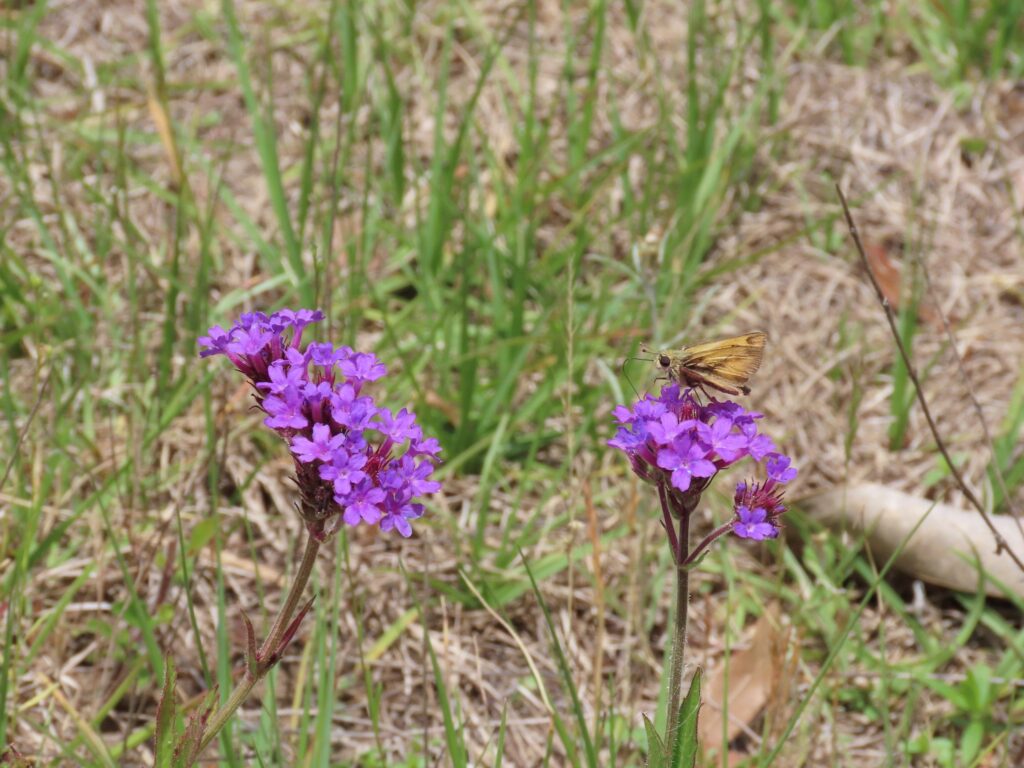
Our first exotic Verbena is Tuberous Vervain (Verbena rigida). Tuberous Vervain typically only grows about six inches in height and tends to creep along the ground as it grows. As the name implies, it has a tuberous root and it also spreads laterally. Tuberous Vervain grows well in lawns, gardens, parking lot islands, and highway medians in its preferred dry, sandy soils and sweltering heat. It’s by far the showiest Vervain we’re discussing today with a peak bloom time of April and a profusion of flower stalks. Each stalk is stuffed with deep-magenta flowers. It’s commonly sold as an ornamental because of this. This species is also the most aggressive of our exotic Vervains, forming dense patches in good growing conditions. However, in most disturbed habitats it’s a net positive but it does have the capacity to invade sensitive habitats.
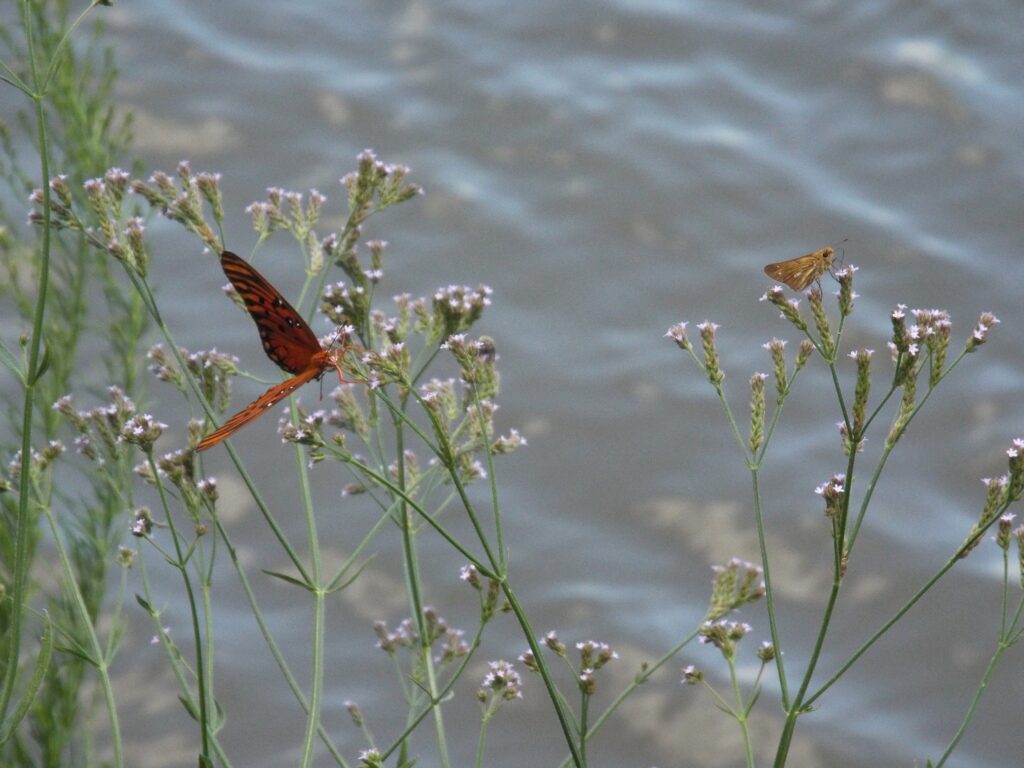
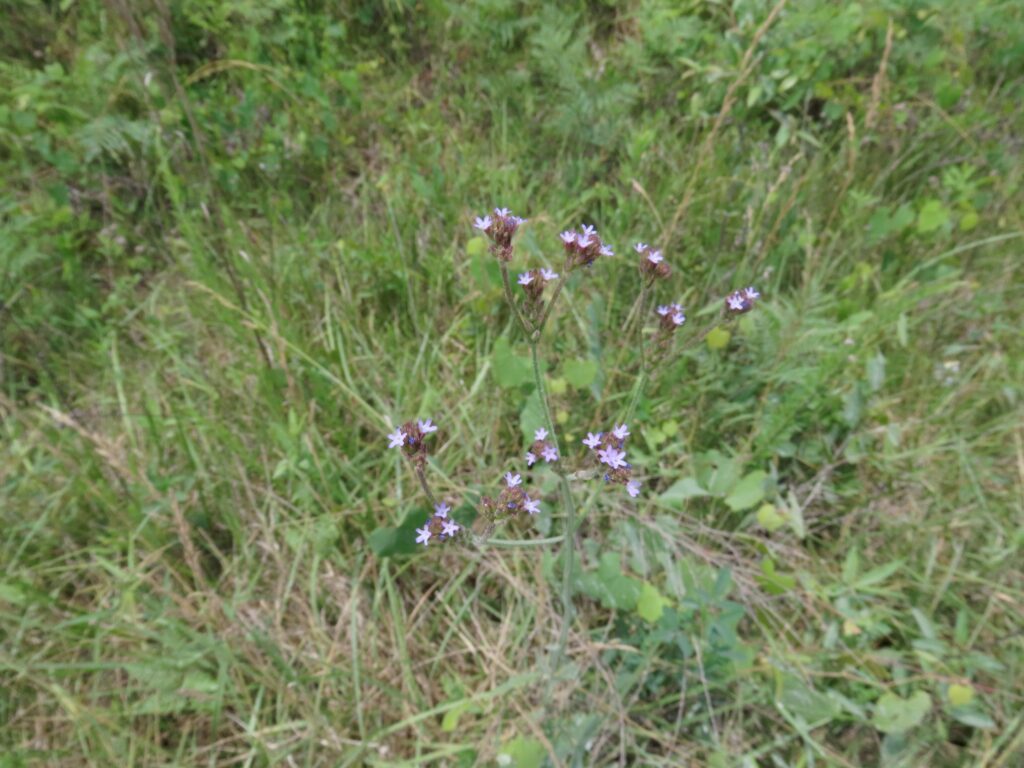
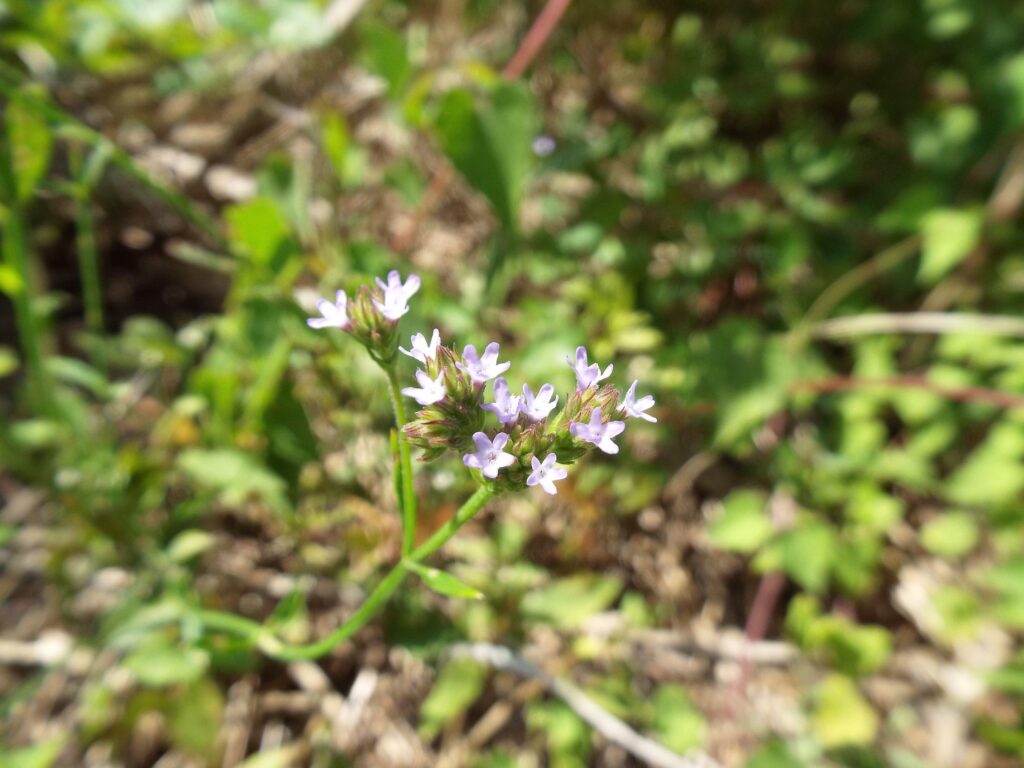
The last three species we’re discussing are all exotic species and they’re a real bugger to tell apart. These species are Brazilian Vervain (Verbena brasiliensis), Purpletop Vervain (Verbena bonariensis), and Brazilian Purpletop Vervain (Verbena incompta). Verbena incompta truly doesn’t have a distinct common name, so I’m referring to it by an amalgamated common name here. It was recently split off from Purpletop Vervain and looks incredibly similar to it, but is commonly referred to as “Brazilian Vervain” in the literature, it’s a confusing mess. So I’m just going to talk about the difference between Brazilian Vervain and the two Purpletops collectively. All three species are tall with skinny, stiff stems, and sparse, serrate, and simple leaves. They usually grow about four feet in height and have clusters of small magenta flowers. Brazilian Vervain has small, paler flowers on narrow, tubular flower clusters. The tube of the flower itself tends to be short, with the flower just sticking above the bracts. The Purpletop Vervains are often sold as ornamentals in seed mixes and have several showy ornamental varieties. However, the wild Purpletop Vervains are more subdued than their cultivated siblings. They have flowers with a deeper magenta and clusters that tend to fan out. The tube of the individual flower sticks up much further above the bracts. All three of these species will grow just about anywhere. They are extremely common on roadsides, fallow fields, abandoned lots, and any soil that has been heavily disturbed. Their flowers are often frequented by small butterflies and bees. Purpletops will bloom from May through August and Brazilian from April clear through October. Their habit of blooming in the dead of summer means they’re sometimes the only thing producing nectar in July and August, which makes them an important nectar sources for pollinators in degraded habitats, especially in urban areas.
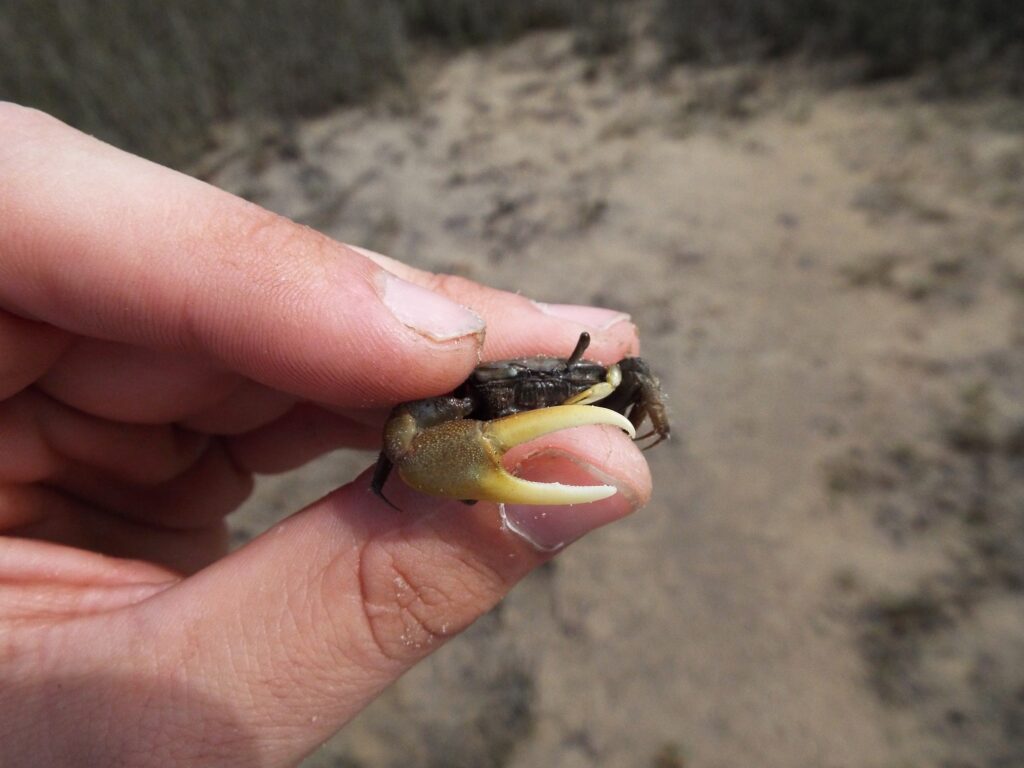

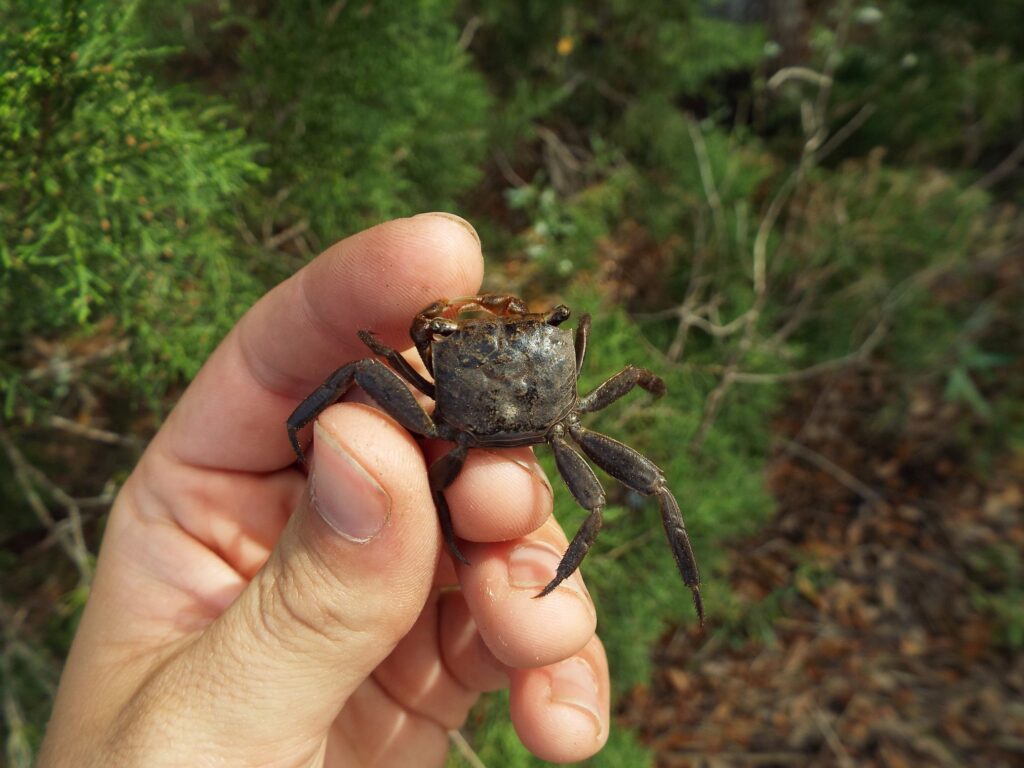
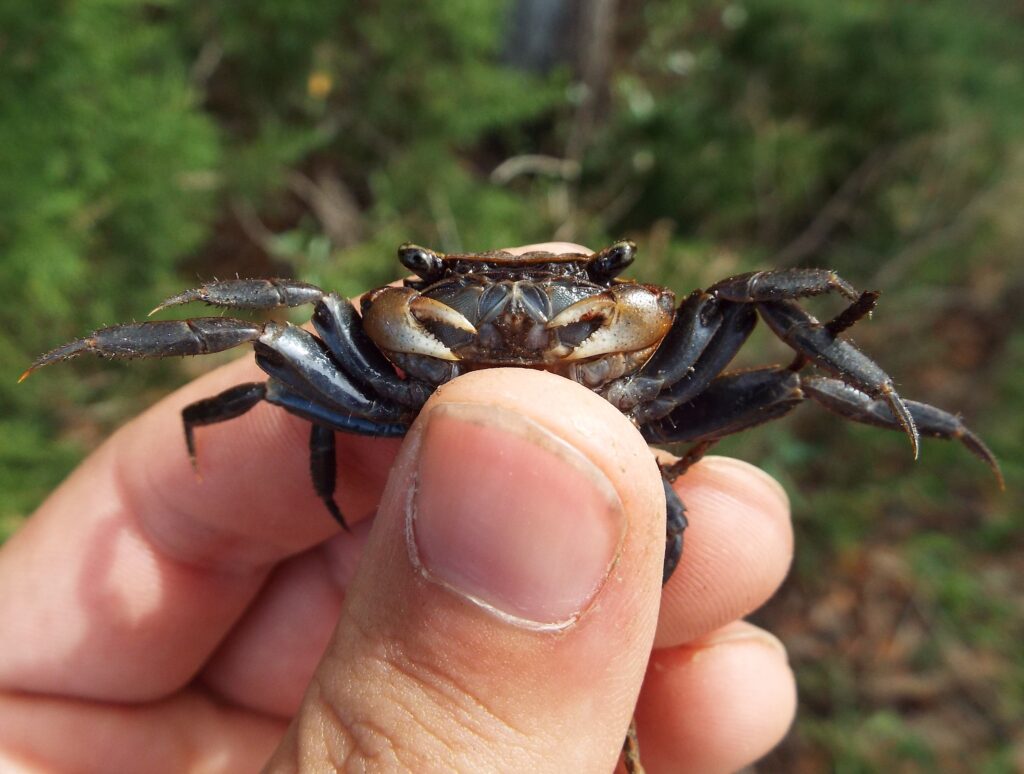
This week for Flora and Fauna Friday we have a trio of catawampus crustaceans and their four-cornered cousin: the Fiddler Crabs (Genera Minuca and Leptuca) and the Squareback Marsh Crab (Armases cinereum).
Here on Edisto we have three species of Fiddler Crab: the Red-jointed Fiddler Crab (Minuca minax), the Atlantic Marsh Fiddler Crab (Minuca pugnax), and the Atlantic Sand Fiddler Crab (Leptuca pugilator). We also have the Squareback Marsh Crab, a similarly sized common crab belonging to a different family and with a very different life-style. All four of these crabs are about two inches in width with an overall drab brown or grayish-brown appearance. Our three Fiddler Crabs have a deep, rounded but boxy body and eyes on pedestals that stick up well above it. Fiddler Crabs are distinctly sexually dimorphic, meaning males and females are clearly distinguishable. Male fiddler crabs have one massively oversized claw that they use for courtship and fighting amongst themselves. This claw is roughly half the size of their abdomen and they can often be seen waving it around to woo the ladies and scare off the other lads.
Male and female Squareback Marsh Crabs on the other hand look pretty much the same. They have a broad, flat, square body, wideset eyes on short stalks, and small even-sized claws. They all come in a uniform shade of pluffmud gray-brown. They spend their lives in the marsh fringes and can often be found running through lawns and clinging to garage walls, like a cockroach, at homes built near the high-water line.
Our three Fiddler Crabs can be a bit tricky to tell apart at a glance but they have a few key features and lifestyle differences we can identify them with. The Atlantic Sand Fiddler Crab is likely the one you’re most often to notice. They make their burrows in sand and are a common sight on salt flats in the high marsh. In summer, they can often be seen moving in huge herds through these salt flats. They have a fairly colorful appearance of an ash-gray back with a Rorschach-esque pattern embedded in it and occasionally a splash of royal-purple between the shoulders. The middle segments of their limbs are often a deep pink-orange too. The Atlantic Marsh Fiddler Crab, as the name suggests, prefers to live in mud. You’ll find them in the low-marsh making burrows in the pluffmud. They have a more reserved appearance, with a predictable gray-brown body to match their pluffmud abode and claws a bone-white or faded-yellow. The Red-jointed Fiddler Crab has, you guessed it, red joints. There are crimson patches on practically all of its joints as well as the edge of the carapace. Its appearance and lifestyle are somewhere in between the other two. Its back ranges from mud-gray to sand-white and its claw can be tan to reddish-brown. They’re notable for preferring lower salinities and are more common farther inland as well as in brackish systems.